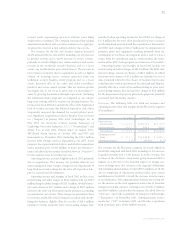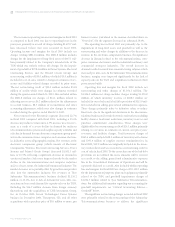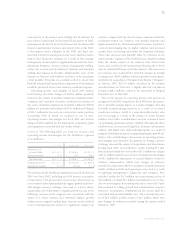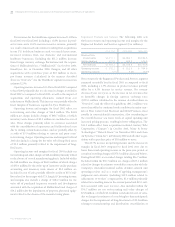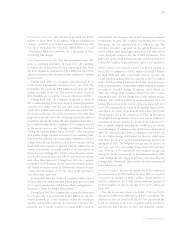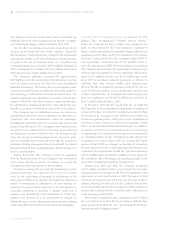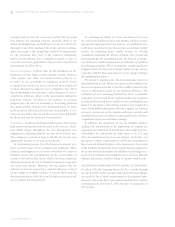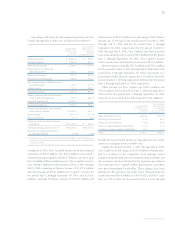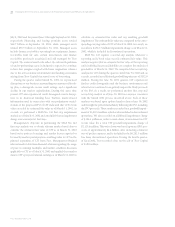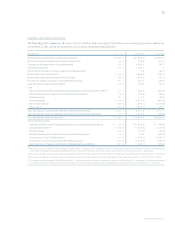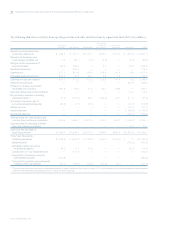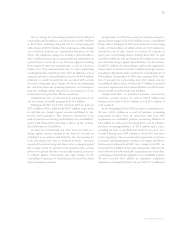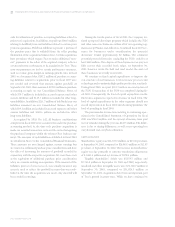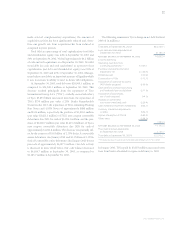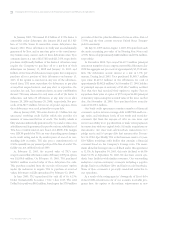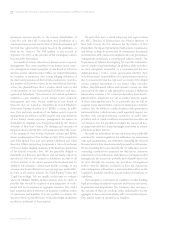ADT 2003 Annual Report Download - page 44
Download and view the complete annual report
Please find page 44 of the 2003 ADT annual report below. You can navigate through the pages in the report by either clicking on the pages listed below, or by using the keyword search tool below to find specific information within the annual report.
42
Company believes that the accelerated method that presently
best achieves the matching objective described above is the
double-declining balance method based on a ten-year life for the
first eight years of the estimated life of the customer relation-
ships converting to the straight-line method of amortization
for the remaining four years of the estimated relationship
period. Actual attrition data is regularly reviewed in order to
assess the continued applicability of the accelerated method of
amortization described above.
Revenue Recognition Contract sales for the installation of fire
protection systems, large security intruder systems, undersea
cable systems and other construction-related projects are
recorded on the percentage-of-completion method. Profits
recognized on contracts in process are based upon contracted
revenue and related estimated cost to completion. The risk of
this methodology is its dependence upon estimates of costs to
completion, which are subject to the uncertainties inherent in
long-term contracts. Revisions in cost estimates as contracts
progress have the effect of increasing or decreasing profits in
the current period. Provisions for anticipated losses are made
in the period in which they first become determinable. If esti-
mates are inaccurate, there is risk that our revenues and profits
for the period may be overstated or understated.
Income Taxes Estimates of full year taxable income of the various
legal entities and jurisdictions are used in the tax rate calcula-
tion, which change throughout the year. Management uses
judgment in estimating what the income will be for the year.
Since judgment is involved, there is risk that the tax rate may
significantly increase or decrease in any period.
In determining income (loss) for financial statement pur-
poses, we must make certain estimates and judgments. These
estimates and judgments occur in the calculation of certain tax
liabilities and in the determination of the recoverability of
certain of the deferred tax assets, which arise from temporary
differences between the tax and financial statement recognition
of revenue and expense. SFAS No. 109 also requires that the
deferred tax assets be reduced by a valuation allowance, if based
on the weight of available evidence, it is more likely than not
that some portion or all of the recorded deferred tax assets will
not be realized in future periods.
In evaluating our ability to recover our deferred tax assets
we consider all available positive and negative evidence includ-
ing our past operating results, the existence of cumulative losses
in the most recent fiscal years and our forecast of future taxable
income. In estimating future taxable income, we develop
assumptions including the amount of future state, federal and
international pre-tax operating income, the reversal of tempo-
rary differences and the implementation of feasible and prudent
tax planning strategies. These assumptions require significant
judgment about the forecasts of future taxable income and are
consistent with the plans and estimates we are using to manage
the underlying businesses.
We intend to maintain this valuation allowance until it is
more likely than not the deferred tax assets will be realized. Our
income tax expense recorded in the future will be reduced to the
extent of offsetting decreases in our valuation allowance. The
realization of our remaining deferred tax assets is primarily
dependent on forecasted future taxable income. Any reduction
in estimated forecasted future taxable income including but not
limited to any future restructuring activities may require that
we record an additional valuation allowance against our deferred
tax assets. An increase in the valuation allowance would result
in additional income tax expense in such period and could have
a significant impact on our future earnings.
In addition, the calculation of our tax liabilities involves
dealing with uncertainties in the application of complex tax
regulations in a multitude of jurisdictions. We recognize poten-
tial liabilities for anticipated tax audit issues in the U.S. and
other tax jurisdictions based on our estimate of whether, and
the extent to which, additional taxes will be due. If payment of
these amounts ultimately proves to be unnecessary, the reversal
of the liabilities would result in tax benefits being recognized in
the period when we determine the liabilities are no longer nec-
essary. If our estimate of tax liabilities proves to be less than the
ultimate assessment, a further charge to expense would result.
DISCONTINUED OPERATIONS OF TYCO CAPITAL (CIT GROUP INC.)
On July 8, 2002 the Company divested of Tyco Capital through
the sale of 100% of CIT’s common shares in an IPO. Accordingly,
the results of Tyco Capital are presented as discontinued oper-
ations for all periods. Prior year amounts include Tyco Capital’s
operating results after June 1, 2001, the date of acquisition of
CIT by Tyco.
TYCO INTERNATIONAL LTD.
Management’s Discussion and Analysis of Financial Condition and Results of Operations



